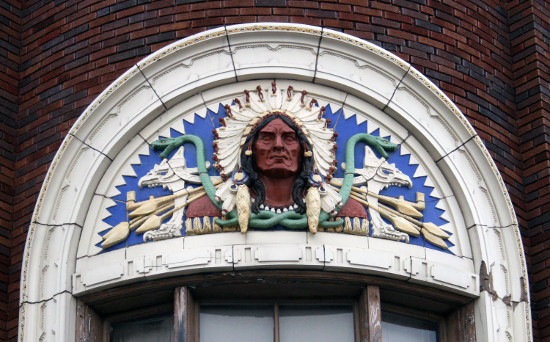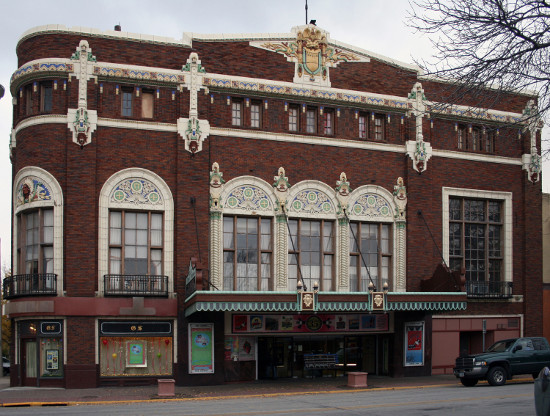
At the corner of Third Avenue and 19th Street in the Rock Island District is a glazed terra-cotta bust of an American Indian wearing a war bonnet that encircles his head, almost like the traditional painting of a halo. Arrows, peace pipes, and entwined snakes are also included in the symmetrical composition. This 10-foot-wide relief is placed above the second-story window on the rounded corner of the Fort Armstrong Theatre building.
Though the artwork is ornate, the dominant central face gives it a strong point of emphasis. The angular structure of the face and surrounding triangular patterns are counterbalanced by the overarching half-circle and circular shapes radiating from the composition's center.
The decorative patterns around the other second-floor windows and the building's outline are also composed of these geometric shapes and Native American symbols. The ivory-, blue-, yellow-, red-, and green-colored glaze stands out against the theatre's dark-red brick exterior.
The wealth of patterns and use of materials are similar to the architectural designs of Louis H. Sullivan, the era's most influential architect. The company that produced these ceramics, the Midland Terra Cotta Company in Chicago, was also employed by Sullivan.
The theatre opened in 1921, a time of stylistic transition between elaborate Art Nouveau and streamlined Art Deco. It was also when themed theatres were coming into vogue. The combined influence of these trends makes the Fort Armstrong's architecture fascinating, and it is on the National Register of Historic Places.
The theatre was named after the fort where the Black Hawk War officially ended with a treaty-signing. Shortly before construction began on the theatre, Rock Island had celebrated the centennial of the military fort's construction. As part of the centennial celebration, members of the Sauk tribe - including Black Hawk's great grandson, Jesse Ka-ka-que - were invited to Rock Island. This focus on the area's early history undoubtedly influenced the theatre's name and theme.

Silent movies as well as musical and comedic presentations were featured at the theatre until the introduction of "talking pictures" in the late 1920s. With the advent of suburban movie complexes in the '60s, the theatre - now named the Fort - declined; for a brief time, it showed adult films. It closed in the early '70s.
Saved from possible demolition, the theatre was extensively renovated from 1977 through 1979 after it became the Circa '21 Dinner Playhouse (named after the year of the theatre's opening). Circa '21 is currently starting its 35th season.
Bruce Walters is a professor of art at Western Illinois University.
This is part of an occasional series on the history of public art in the Quad Cities. If there's a piece of public art that you'd like to learn more about, e-mail the location and a brief description to BD-Walters@wiu.edu.








